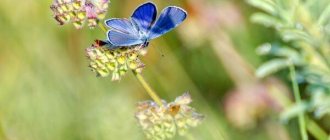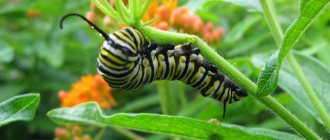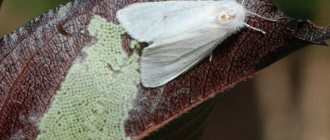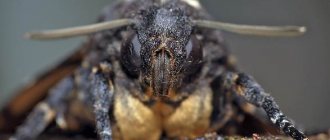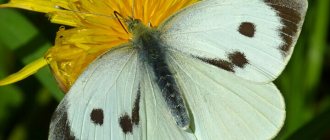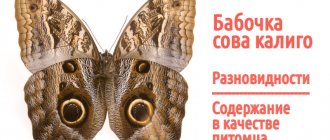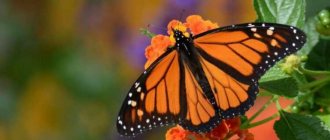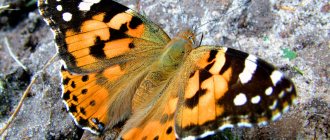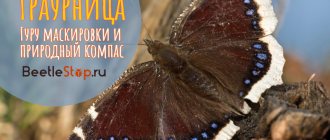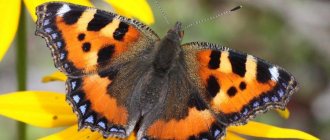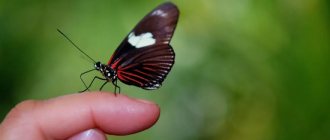Bluebirds Icarus are small butterflies with wings of a rare azure color. They flutter among the flowers, as if particles of the sky had descended onto a sunny meadow.
Even the hairs on the body of the Blueberry Icarus are colored a delicate blue with a purple tint.
The largest family of bluebirds includes about 5,200 species of diurnal butterflies of modest size, usually not exceeding 2.5-3.5 cm. They are distributed mainly in the tropics, but they can also be found here.
Description
Blueberry Icarus is a small butterfly with a wingspan of 25-35 mm. In males, the wings are blue, bordered by a narrow black stripe, in females they are dark brown and have a blue coating only at the root of the wings, and their edges are dotted with orange spots. The lower part of the wings of both sexes is gray, with many black ocellated spots scattered throughout the background. Occasionally, females are found with a blue coating on the upper side of the wings.
NOT BLUE DOUBLES
Even in English, bluebirds are called “blue butterflies,” but in this family you can also find species with red wings. Males of the Tekla genus are green and purple. In addition, they sport thin, easily detachable tails on their hind wings. But despite the “wrong” coloring, they are all classified precisely in this family based on the totality of their characteristics. Bluebirds are distinguished by shortened forelegs with developed claws in males, the absence of brushes on the shins and elongated eyes surrounded by rings of white scales.
Nutrition and lifestyle
Blueberry Icarus can be observed from mid-April to early October. She received her name in honor of the son of Daedalus, who became famous for flying on homemade wings from the Cretan labyrinth. This is one of the most common butterflies in the middle zone. Found in open meadows and heathland. Blueberries are active in warm, sunny weather, fluttering over thickets of legumes, the nectar of which they feed on. They often “graze” in alfalfa fields. Caterpillars eat leaves of food plants. In warm, clear weather, butterflies can be seen near puddles or small sources of water. In addition, they try to stay close to anthills where their grown larvae parasitize.
CATERPILLARS-LOUNDERS
Bluebirds have one interesting feature. The caterpillars of most of their species, at certain stages of their development, end up in anthills and parasitize their inhabitants. Such is the blueberry Icarus. The young caterpillars that hatch from the egg first feed on the leaves. They secrete a secretion with a special smell, thus “disguising” themselves as ant larvae. They take them to the anthill and feed them along with their own offspring. Moreover, the caterpillars not only rob the larvae, but also eat them. However, the ants have found a way to resist these insidious predators. The smell of their larvae is constantly changing, and only those caterpillars survive that best managed to adapt to the standard. This does not allow the bluebirds to increase their numbers too much and bring the anthill to death.
Life cycle
With the onset of warm spring days, the fertilized female lays 1 greenish egg on the upper side of the leaves of various herbaceous plants; most often she chooses plants near the anthill. After about a week, the caterpillars hatch. They move to the underside of the leaf, eating the entire leaf blade.
Having reached the last stage of development, the caterpillar settles down for the winter, settling in the stem at the base of the plant. In spring, the larvae develop slowly, usually over 2 months, after which they pupate in the top layer of soil. Interestingly, ants often carry pupae into various cracks or other hiding places in the ground. The pupal phase lasts about 2 weeks before the adult butterfly emerges.
Reproduction and life expectancy of blueberry
The life of a blueberry consists of a sequence of transformations that can be described by a simple chain: egg - caterpillar - pupa - butterfly. It is known that the blueberry produces two generations per year, and the processes of reproduction of adult individuals take place in late spring and throughout the summer.
The offspring born in the spring develop and grow quite quickly, in contrast to the summer brood, which gains the ability to turn into a butterfly only after nine or ten months. Unfortunately, butterflies of the blueberry family have the lowest life expectancy according to statistics, from two to four days.
Interesting facts about butterflies
- The smallest butterfly, acetosia, has a wingspan of only about 2 millimeters. The largest, Tisani agrippina, has up to 28 millimeters.
- Butterflies, like elephants, feed using their trunk. More precisely, a proboscis.
- In total, there are about 165 thousand species of butterflies and moths in the world. Yes, yes, exactly thousands! Moreover, most of them prefer to lead a nocturnal lifestyle.
- Hawkmoths, night moths, can howl in a wolf-like manner. This howling buzzing mimics that of a queen bee, allowing the hawkmoth to freely enter the beehive and feast on honey, which makes up a fair share of its diet.
- Butterflies are found on all continents except Antarctica.
- A butterfly's eyes are made up of more than a thousand faceted elements each.
- The receptors responsible for taste are located on the legs of butterflies.
- Some species of butterflies lay more than a thousand eggs during their very short lives, from which caterpillars then hatch.
- Many other species, such as birds and chameleons, readily feed on butterflies.
- The northernmost butterflies live less than a thousand kilometers from the North Pole, on Canada's Queen Elizabeth Island.
- In China, India and some countries of South America, the population does not hesitate to eat butterflies.
- Some species of butterflies can reach speeds of over 60 km/h during flight, covering a distance equal to twenty to thirty thousand of their own body lengths in a minute of flight.
- Most butterflies are afraid of water, but, for example, a lilac moth can calmly emerge if it accidentally falls into the water, shake itself off and fly on.
- Monarch butterflies understand medicinal plants and know how to use them for medicinal purposes if their offspring need help.
- Butterflies do not have an organ called a heart.
- Butterflies distinguish only three colors - red, yellow and green.
- There are also vampire butterflies that feed in the same way as mosquitoes do - calyptra eustrigata. However, only males feed on blood, while females prefer plant foods.
- The skeleton of a butterfly, or rather the exoskeleton, is not inside its body, but outside. All internal organs are located inside it.
- The cabbage butterfly is very prolific. If all the offspring of at least one cabbage tree survived, so many of its descendants would be born in a season that they would weigh three times more than all the people on Earth combined.
- In China, butterflies are considered a symbol of love and lovers.
Natural enemies of blueberry butterflies
Photo: Blueberry butterfly on a flower
There are many of them at all stages of development.
Mainly these are:
- birds;
- rodents;
- lizards;
- toads;
- spiders.
Danger threatens bluegills throughout their lives, starting from the egg stage - adult butterflies, which are able to fly away from most predators, are least exposed to it. But not from everyone: their main enemy is birds, which are much faster, they are able to catch butterflies right in the air, or lie in wait when they are resting.
Insects can also hunt butterflies: dragonflies do this right in flight, spiders set nets on them, and praying mantises guard flowers. But the threat is still especially great for caterpillars: they are not able to escape from a predator, and the same birds are much more willing to attack them, because the butterflies still need to be caught, and one at a time. There are usually a lot of caterpillars close to each other, and you can devour dozens at once. Caterpillars are especially often used as food for voracious chicks.
Therefore, many blueberry caterpillars have defense mechanisms, due to which a relatively large number of them survive: for example, placing eggs on the ovary of a flower, so that the caterpillar is then reliably hidden from predators most of the time. Or interaction with ants, allowing you to overwinter or develop in an anthill without danger.
People spoil the lives of bluegills much more: due to the deterioration of the environment and the disappearance of their habitats, the population of some species has greatly decreased, and they are in danger of extinction - predators were not able to bring it to this point.
Appearance and features
The dimensions are small: the wingspan usually ranges from 20 to 40 mm. In rare cases, it can reach 60; this is typical for tropical butterflies; smaller species live in the temperate zone. The wings are wide, allowing you to glide. Some pigeons have “tails” at their ends, but for the most part they are rounded, and when folded they are close to a triangular shape, but smoothed. The color of the wings is blue, from pale to bright, heavenly color. There are splashes of black and white, as well as yellow spots. The wings can also be brown or fiery in color. Males have a much brighter color than females, since it falls to them to attract a partner, and the female only makes a choice in favor of one of the males.
In addition, the female's wings usually have less pronounced spots or no spots at all. In addition to these colors, there are others, because there are a lot of blueberries, and they are all different: there are whitish-yellow, white with black specks, gray with blue, and so on. The name of this butterfly comes from the widespread blueberry Icarus. The lower part of the wings of bluebirds is painted in a protective color - usually gray or brown, which allows them to camouflage themselves on tree trunks and in bushes. They have club-shaped antennae and short palps. Males also differ in that their front legs are poorly developed; they move on the middle and hind legs, but in females all three pairs are equally developed.
This butterfly really loves warm, tropical weather - a significant part of its species is found only in the tropics, less in the subtropics, and hardly one in ten is found in the temperate zone. But these species, for example, the Blueberry Icarus, are able to tolerate significant temperature changes and live in fairly cold areas. The range is very wide and includes all parts of the world. You won't find bluebirds except in the Arctic and Antarctic. Although relatively few species live in temperate regions, their populations are quite large, and they are especially common in Central and Eastern Europe. They prefer open, sunny areas with few trees or shrubs for living.
These are meadows, gardens, clearings, forest edges, banks of rivers and lakes. Blueberry Icarus is very fond of alfalfa fields and is found there in large quantities. Less common, but also found, are bluebirds right in populated areas, where they can live in parks or gardens. The largest number of these butterflies live in flat areas; with increasing altitude, the diversity of species and frequency of butterflies decreases, but up to 1,500 meters there are quite a lot of them, some are also found at altitudes up to 3,300 meters. They usually do not move long distances - they can fly to a more attractive area, but usually located within a few hundred meters. Subsequently, they spend their entire short life on it or nearby.
Caterpillars can attack a variety of plants, depending on the species. Thus, the tailed caterpillar prefers the leaves of trees and shrubs, and the many-eyed caterpillar prefers buckwheat and legumes. Some can harm garden trees or shrubs. It is interesting that not all blueberry caterpillars eat only plants - some can diversify their menu with living creatures, or even feed only on them. Among their victims are: aphids; mealybug; ant larvae; other small insects; other caterpillars, including those of the same species. Yes, this is a rare example of predator caterpillars, and sometimes they engage in cannibalism - they are very different from the larvae of many other butterflies, which are harmless and eat only leaves!
Many of them nest well in anthills, forcing the ants to feed themselves - they do this because of the liquid that their nectar-bearing gland produces. Some also have organs that produce sounds, which the ants obey. In their adult form, blueberries feed primarily on nectar, and in this regard they are not at all picky: they like clover most of all, but almost any flower suits them. Moreover, they are also able to feed on the sap of trees and rotting fruits, secretions of aphids and even bird droppings. There are many species of blueberry, and some of them can even feed on foods that are extremely interesting for butterflies: for example, some are attracted to canned food and lard.
They love the sun and warmth, and are active only during the day, and when it ends, they look for a secluded place to spend the night in. In adult form they do not live long, from 3-4 days to 3 weeks, depending on the species. That is why, although their population is quite large, they are much less common than urticaria. Most often, development occurs in two or three generations, but in warm areas there can even be four. As a result, you can find the blueberry not only throughout the summer, but also during most of the spring and autumn. Blueberry caterpillars and sometimes pupae overwinter: they can do this not on the stem of a plant or in warm litter, or right on the ground, in a mulberry network.
Some blueberries overwinter in anthills, or ants hide them in shelters in the ground, for example, in cracks. The caterpillars are notable for the fact that they live alone and secretly; they are difficult to notice on plants due to their color matching the leaves - they are not only the same shade of green, but even reproduce veins. Many bluebirds are closely related to ants - they have relationships with them ranging from symbiotic to parasitic - depending on the type of butterfly . This is also why they are remarkable, because in many other butterflies, for example, urticaria or lemongrass, the caterpillars suffer from ants, but the blueberry is not in danger from them - and on the contrary, it itself is dangerous for them.
Bluebirds live alone and are prone to territoriality: usually adults live in one place all their lives and tend to defend it: they can attack other bluebirds or bees and other insects, trying to drive them away. During the breeding season, males try to attract a female, but at other times they can even show aggression towards her. As a fully metamorphosed insect, the blueberry goes through four standard stages. Their duration and characteristics can vary greatly from species to species; below we will briefly consider how reproduction and development to adults occurs in the spring blueberry. Butterflies of the first generation lay eggs in early summer, the second in mid-August. There are usually 50-80 eggs, they are laid one per leaf or fruit bud by females of the first generation, and on the ovary of fruits by females of the second generation. The egg develops, depending on weather conditions, from 3 to 7 days - on cold days it takes longer.
Then the caterpillar appears, they can feed on a large number of plants, and not only leaves, but also flowers, buds, fruits - they are even preferable because they are more nutritious. Thus, caterpillars of this species can become a garden pest if they end up on currants, apple trees, and pears. They can come into contact with ants, but they do not always do this - researchers suggest that the spring blueberry caterpillar does this only when there is a lack of nutrients or after experiencing a threat from a predator. After two to three weeks of intensive feeding, the caterpillar pupates, and after another week the butterfly breaks through the cocoon . The situation is different with the second, or, in warm areas, the third generation per year: by the time the caterpillar grows to a sufficient size, it becomes colder, and therefore it goes into hibernation, choosing a warm place. Sometimes it pre-pupates and often hibernates in an anthill.
Caterpillars of bluebirds associated with ants live near anthills, and the pupae lie right in them. They can also be attached to branches or leaves of trees, or lie directly on the ground. After the appearance of the caterpillars, their lifestyle depends on what species they belong to: they spend all their time on plants, feeding on leaves and being exposed to dangers, until they turn into pupa. Others fared much better: for example, the Alcon blueberry lays eggs in a gentian flower. They spend the first time inside the flower, feeding on its pulp, protected from the attacks of predators, until they gnaw a hole in it and get out. This takes a couple of weeks. Then they go down and wait for the ants to find them. Thanks to the substances they produce, they don’t spend long waiting: they quickly find them and take them to the anthill. They continue to grow there in complete safety, then pupate there. In a similar way, many bluegills protected themselves from the dangers of existing in the form of a caterpillar.
Food for Blueberry Icarus
The favorite food of Ikars is sugary syrup of thistle and marjoram. Based on the wide distribution of the butterfly throughout Europe, one can judge that it does not turn away from other plant species.
In the larval stage, insects feed on the leaves of plants from the legume family. The caterpillars of some bluebirds themselves are “milked” by ants, just like aphids. They are forced to secrete sweet juice, irritating the skin with antennae and paws.
Males need to constantly replenish their supply of minerals to create sex hormones. They satisfy this need by extracting the necessary substances from puddles and cakes of manure, gathering around them in large flocks.
Types of hawk moths
Wine hawkmoth (also called "grape hawkmoth" or "rose hawkmoth") is found on grapevines. This species is distinguished by its bright color, large size and sharp spine.
The lilac hawk moth is one of the largest butterflies that adorns the hawk moth family. Its wingspan ranges from 90 to 120 mm. The hind wings are colored pink, and rings can be seen on the abdomen, some of which are also pink, while others are brown. The lilac hawk moth differs from other species in its proboscis - its length is approximately the same as the insect’s body. The caterpillar can be of two colors - green or purple.
Hawkmoth is a hummingbird of the middle zone. Indeed, as you can see from the photo, it won’t be difficult to find common features between a butterfly and a bird. It's a joke of nature - hummingbirds are the tiniest birds, their weight is usually no more than 2 g, and hawk moths are the leaders among butterflies in size. While feeding, insects do not sit on flowers, but seem to hover over them, quickly flapping their wings. It seems that a tiny bird is hovering over the bud. In central Russia, one of the most common species is the bedstraw hawk moth.
The linden hawk moth is easily recognizable due to its front wings with jagged edges, the span of which can be from 60 to 80 mm. And here we have photographs of the largest butterflies in the world. Color ranges from olive green to rust with irregular dark spots. The hind wings are yellow ocher. The caterpillar of this species is green with red and yellow stripes. You can see it in summer on birch, alder and linden trees.
The moth hawk moth is not protected from the dangers that await it in its natural habitat everywhere. For example, wasps and moths can lay eggs on the surface of the body of a butterfly or pupa. The emerging parasites use the internal organs of the hawk moth as food. The night hawk moth can also be killed by chemical insecticides used by humans, as well as be eaten by birds. Therefore, the insect is forced to defend itself, sometimes using unusual methods. For example, a hawkmoth larva can easily feign death during a bird attack. By the way, here is a list of all moths.
Lifestyle
The blueberry is a diurnal butterfly that loves heat and active sun.
She spends the night in a quiet place. She looks like a gentle fairy-tale creature, but she has a wayward character. Males love to get into fights over habitat areas, attack strangers, butterflies of other species, and even small birds. The blueberry, by its nature, periodically communicates with ants
Using microwaves, she is able to attract the attention of the colony and control the behavior of ants
Caterpillars are frequent guests in anthills. They settle there and live in winter. They feed on ant larvae. Then the transformation into a pupa occurs. A month later, a butterfly emerges from it, which no longer needs to live in the anthill.
National butterfly of Finland
Main article: Celebration of the 100th anniversary of Finnish independence
In honor of the 100th anniversary of Finnish independence in 2022, a vote was organized for a butterfly that would become a symbol of the country. The Finnish Environmental Protection Union, the Vuokko Nature Protection Foundation and the Entomology Association took part in organizing the voting. The list for the title included 20 species living in the country. Voting was carried out on a special website from March 15 to June 14, 2022. The results were summed up on June 15, 2022. Based on the voting results, the spring blueberry was chosen as the national butterfly of Finland, receiving 17.3% of all votes - 6,305 people voted for it.
